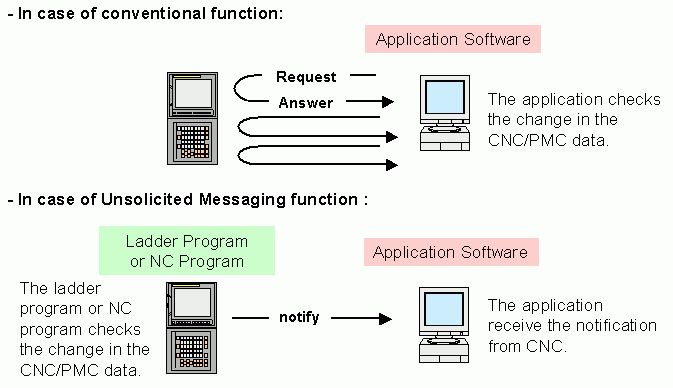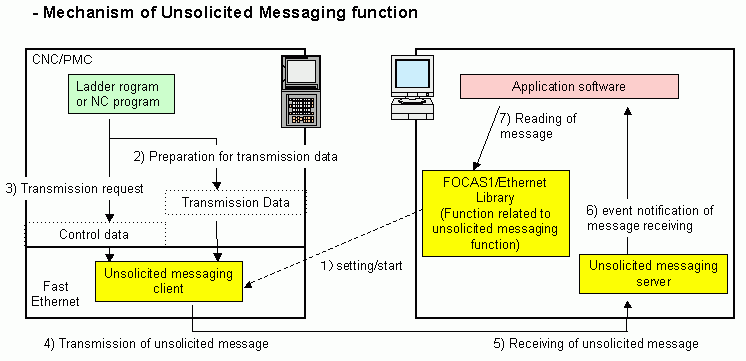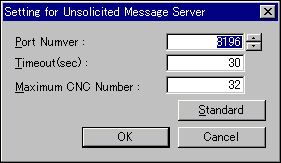- Outline of unsolicited messaging function
- Setting to use the unsolicited messaging
- Control data and Message transfer mechanism for the unsolicited messaging
- Ethernet functions for the unsolicited messaging function
- Making method of application which uses the unsolicited messaging function
- Notification of using with Windows Vista Business
In the Unsolicited messaging function, the Message can be voluntarily notified from CNC to the personal computer according to the instruction of the ladder program or the NC program Note1). So, in the PC application, the state of CNC can be observed without the polling process. Arbitrary data of PMC or Macro variables Note1) can be transmitted as the Message. In the PC application, the polling process to inquire the state of CNC regularly becomes unnecessary by using this function.
The unsolicited messaging issues the window message to the PC application internally and notifies the Message. So, Visual C++ is necessary for making the application.
Note1) NC program and Macro variable can be used only by 30i/31i/32i/35i, 0i-D/F and PMi-A.
This function is supported at the following ethernet function.
- 16i/18i/21i, 0i-B/C/D/F, Power Mate i (Not supported at Ethernet board/Embedded Ethernet)
- Fast Ethernet board
- 30i/31i/32i/35i, PMi-A
- Fast Ethernet board
- Embedded Ethernet


The following items are necessary to use the unsolicited messaging function.
- CNC control software : to be registered onto FROM of CNC.
- 16i
- B0F4/12(M) or later
- B0F4/07(T) or later
- B0H1/17(M) or later
- B1H1/17(T) or later
- 18i
- BDF4/12(M) or later
- BEF4/07(T) or later
- BDH1/17(M) or later
- BEH1/17(T) or later
- 21i
- DDF4/12(M) or later
- DEF4/07(T) or later
- DDH1/17(M) or later
- DEH1/17(T) or later
- 0i
- D4A1/01(M) or later
- D6A1/01(T) or later
- D4F1/01(M) or later
- D6F1/01(T) or later
- PMi
- 88E0/21 or later
- 88F2/04 or later
- 88F1/12 or later
- 30i
- G002/19.9 or later
- G012/19.9 or later
- G022/19.9 or later
- G032/19.9 or later
- * In case of using for Embedded Ethernet.
- G002/23.0 or later
- G002/23.0 or later
- G012/23.0 or later
- G022/23.0 or later
- G032/23.0 or later
- G003/6.0 or later
- G013/6.0 or later
- G023/6.0 or later
- G033/6.0 or later
- 31i
- G101/19.9 or later
- G111/19.9 or later
- G121/19.9 or later
- G131/19.9 or later
- * In case of using for Embedded Ethernet.
- G101/23.0 or later
- G111/23.0 or later
- G121/23.0 or later
- G131/23.0 or later
- G103/6.0 or later
- G113/6.0 or later
- G123/6.0 or later
- G133/6.0 or later
- 32i
- G201/19.9 or later
- * In case of using for Embedded Ethernet.
- G201/23.0 or later
- G203/6.0 or later
- PMi-A
- 88H0/1.0 or later
- CNC side(Fast Ethernet firmware) : to be registered onto F-ROM of CNC.
- 6567/06 or later(16i/18i/21i,Power Mate i)
- 6567/07 or later(0i-B)
- 656W/01 or later(0i-C)
- 658W/01 or later(0i-D)
- 658B/01 or later(0i-F)
- 6569/19 or later(30i/31i/32i)
- 658K/05 or later(PMi-A)
- CNC side(Net control application software) : to be registered onto F-ROM of CNC.
- 656F/11 or later(30i/31i/32i)
- 656F/12 or later(In case of using for Embedded Ethernet of 30i/31i/32i)
- CNC side(Embbeded Ethernet control software) : to be registered onto F-ROM of CNC.
- 656E/11 or later(In case of using for Embedded Ethernet of 30i/31i/32i)
- 658M/04 or later(In case of using for Embedded Ethernet of PMi-A)
- CNC side(Graphic Function 1 for 15") : to be registered onto F-ROM of CNC.
- 60VB/01.8 or later(In case of using for Embedded Ethernet of 30i/31i/32i)
- PC side(Ethernet library) : to be copied onto a suitable folder of the PC. (System32 etc.).
- Fwlib32.dll :
- FOCAS1/Ethernet Libraries(A02B-0207-K732) 1.7 or later(16i/18i/21i,Power Mate i)
- FOCAS1/Ethernet Libraries(A02B-0207-K732) 1.8 or later(0i)
- FOCAS1/2 Libraries(A02B-0207-K737) 2.5 or later(30i/31i/32i/35i, 0i-D)
- FOCAS1/2 Libraries(A02B-0207-K737) 3.9 or later(PMi-A)
- CNC Application Development Kit(A08B-9010-J5555#ZZ12) 1.1 or later(0i-F)
- Fwlibe1.dll :
- FOCAS1/Ethernet Libraries(A02B-0207-K732) 1.7 or later(16i/18i/21i,Power Mate i)
- FOCAS1/Ethernet Libraries(A02B-0207-K732) 1.8 or later(0i)
- FOCAS1/2 Libraries(A02B-0207-K737) 2.5 or later(30i/31i/32i/35i, 0i-D)
- FOCAS1/2 Libraries(A02B-0207-K737) 3.9 or later(PMi-A)
- CNC Application Development Kit(A08B-9010-J5555#ZZ12) 1.1 or later(0i-F)
- PC side(Unsolicited messaging server) : to be installed into the PC.
- UMsgServ.exe :
- FOCAS1/Ethernet Libraries(A02B-0207-K732) 1.7 or later
- FOCAS1/2 Libraries(A02B-0207-K737) 2.5 or later(30i/31i/32i/35i, 0i-D, PMi-A)
- CNC Application Development Kit(A08B-9010-J5555#ZZ12) 1.1 or later(0i-F)
Install method of Unsolicited messaging server
- Copy the UMsgServ.exe onto the suitable folder.
- Input the following command from the command prompt.
- > UMsgServ.exe -Install [Enter]
- By the above operation, the Unsolicited messaging server will be started automatically. after the next reboot of the PC.
Uninstall method of Unsolicited messaging server
- Right-click the icon of the "Unsolicited Messaging Server" on the system tray, select "Exit" from the menu. The Unsolicited messaging server terminates.
- Input the following command from the command prompt.
- > UMsgServ.exe -Remove [Enter]
- Delete UMsgServ.exe from the installed folder.
Setting method of data for Unsolicited messaging server
- Right-click the icon of the "Unsolicited Messaging Server" on the system tray, select "Setting" from the menu. Following dialog screen for setting will be displayed.
- Set necessary information for each item.
- Port Number :
- Specify the port number for the Unsolicited messaging server. (standard value is 8196)
- Timeout(sec):
- Specify the timeout time to detect an abnormal communication with CNC. (standard value is 30)
- Maximum CNC Number :
- Specify the maximum number of CNCs which can be observed at the same time by the Unsolicited messaging server.(standard value is 32)
- The function of each button is as follows.
- [Standard] :
- resets the setting to the above standard value.
- [ OK ] :
- saves the setting value and closes this screen.
- The setting value will be effective after the restart of the Unsolicited messaging server.
- [ Cancel ] :
- closes this screen without saving the set value.
The following setting is necessary to CNC beforehand, to use the unsolicited messaging function.
- - IP address :
- IP address of destination PC.
- - Port number :
- TCP/UDP port number of destination PC.(Note:The unsolicited messaging function uses TCP and UDP of the same port number.)
- - Control parameter
- It is PMC address or macro variable number to demand the data transmission by the ladder or the NC program.
- Only PMC address ("R","E") can be set for Series 16i/18i/21i, 0i-B/C, and Power Mate i.
- - Transmission parameter
- It is the PMC address and size or the macro number and numbers which becomes the content of the message.
- Only PMC address can be set for Series 16i/18i/21i, 0i-B/C, and Power Mate i.
- - PMC address :
- R address for ladder program to demand data transmission
- - Reading address of PMC data :
- R address for ladder program to demand data transmission
- - Retry number :
- Number of transmission retry to observe communication board transmits data.
- - Timeout time :
- imeout time to observe communication board transmits data.
- - The interval time of the existence signal :
- The interval time of the existence signals which are transmitted while communication board operates.
- - others :
- Please refer to the specification of function for details.
These data can be set from the PC application using cnc_wrunsolicprm() or cnc_wrunsolicprm2().
When you set these data in CNC, these data is saved in S-RAM area of CNC.
- When you use the PMC address for the control parameter(Response Notice method)
- When you use the PMC address for the control parameter(Simple method)(30i/31i/32i/35i, 0i-D/F, PMi-A only)
- When you use the Macro variable for the control parameter(Simple method)(30i/31i/32i/35i, 0i-D/F, PMi-A only)
In the PC side application, the following functions are provided to receive the Message from CNC. (The function specification is described later.)
- - cnc_wrunsolicprm Sets the unsolicited messaging parameters
- - cnc_wrunsolicprm2 Sets the unsolicited messaging parameters(2)
- - cnc_rdunsolicprm Gets the unsolicited messaging parameters
- - cnc_rdunsolicprm2 Gets the unsolicited messaging parameters(2)
- - cnc_unsolicstart Initiates the unsolicited messaging session
- - cnc_unsolicstop Terminates the unsolicited messaging session
- - cnc_rdunsolicmsg Reads the unsolicited messaging data
- - cnc_rdunsolicmsg2 Reads the unsolicited messaging data(2)
- Set the parameter for the unsolicited messaging to CNC.
The parameter for the unsolicited messaging function is set to CNC SRAM area using cnc_wrunsolicprm(). The parameter can be read by cnc_rdunsolicprm(), if necessary.
- Notify the completion of preparing the unsolicited messaging to CNC.
The completion of preparing the unsolicited messaging is notified to CNC using cnc_unsolicstart(). After this call, CNC part can send the Message.
- Add the function to process the unsolicited messaging.
// Example of ON_MESSAGE #define WM_MYMESSAGE (WM_APP + 1) BEGIN_MESSAGE_MAP( CMyWnd, CMyParentWndClass ) //{{AFX_MSG_MAP( CMyWnd ON_MESSAGE( WM_MYMESSAGE, OnMyMessage ) //}}AFX_MSG_MAP END_MESSAGE_MAP( ) LRESULT CMyWnd::OnMyMessage(WPARAM wParam, LPARAM lParam) { LRESULT result; // Process the Message from CNC using cnc_rdunsolicmsg(), etc. return result; }The arguments of the OnMyMessage() function are as follows.
- wParam
- = -3 : The socket communication error occurred.
- = -2 : The unsolicited message server has stopped.
- = -1 : The CNC power was turned off.
- = 0 : The Message from CNC arrived. (normal process)
- = 1 : The CNC power was turned on.
- lParam
- = "Handle for the Message data reading" : in case of wParam = 0 This value can be used as the argument for cnc_rdunsolicmsg().
- = 0 : Other than wParam = 0
Note)
- In case of "wParam = -3" :
- The "Handle for the Message data reading" on the CNC side becomes invalid, so call cnc_unsolicstart() again. When the problem is not solved, investigate CNC power supply, Ethernet cable and I/F board.
- In case of "wParam = -2" :
- The window message cannot be received at the application. So, both the restart of the application and the Unsolicited messaging server is necessary.
- In case of "wparam = -1" :
- The application should wait for the wParam to become "1". And it is necessary to execute the acquisition of the library handle again.
And the OnMyMessage() function can set "RES_CODE" of the PMC data for unsolicited messaging control by setting the return value in "result" when wParam=0. The value of "result" which can be set by the application is as follows.
- result = 0x00, 0x10..0x1F, 0x30..0x3F
- Read the unsolicited messaging data.
The transmitted message data at above OnMyMessage() routine is read by using cnc_rdunsolicmsg().
- Notify the termination of receiving the unsolicited messaging to CNC.
The termination of receiving the unsolicited message from CNC is notified by cnc_unsolicstop() when the PC application finishes.
In Windows Vista, the CNC unsolicited message can not be received when the application for message receiving is executed as "Run as administrator".
